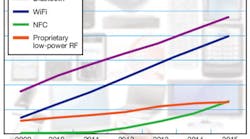These days, referring to consumer electronics as a major market for wireless technology would be a significant understatement. More than 20 billion devicesnotebooks, netbooks, tablets, PCs, cellular handsets, TVs, set-top boxes, game consoles, and 3DTV glasses, to name a feware set to be shipped over the next four years alone. Of particular interest are RF technologies, which are poised to show the highest adoption within these devices. in a report titled, "The World Market for Low-Power Wireless-enabled Consumer Electronics2011 Edition," IMS Research provides market estimates and projections for the adoption of low-power wireless technologies. The technologies covered include Bluetooth, Wi-Fi, ZigBee RF4Ce, ANT+, near-field communications (NFC), and proprietary solutions. Their share of market and projected success is examined across 10 different consumer-electronics devices. According to the report, Bluetooth technology will continue to show the greatest uptake in consumer-electronics devices. The major contributor to this growth is its inclusion in the rapidly growing smartphone segment. That segment is projected to more than double in unit shipments between 2011 and 2015. Additional factors include Bluetooth's growing attach rate in portable computing devices as well as its adoption in active-shutter 3DTV glasses and other emerging devices.
Wi-Fi-enabled consumer-electronics devices also will see a significant boost, primarily due to the smartphone and mobile-computing segments. (The latter boasted a 100% attach rate in 2010.) WiFi's growing implementation within televisions and other homeentertainment devices also factors into this growth, albeit to a lesser degree.
NFC technology is another area showing notable growth. Though currently shipping in low volumes, it is predicted to achieve mass adoption within the next 18 months. This jump is largely attributable to NFC's integration into cellular handsets and adoption in mobile-computing devices. More than 100 million handsets are expected to be shipped with NFC in 2012. By 2015, close to 200 million NFC-integrated mobile devices will be shipped.
